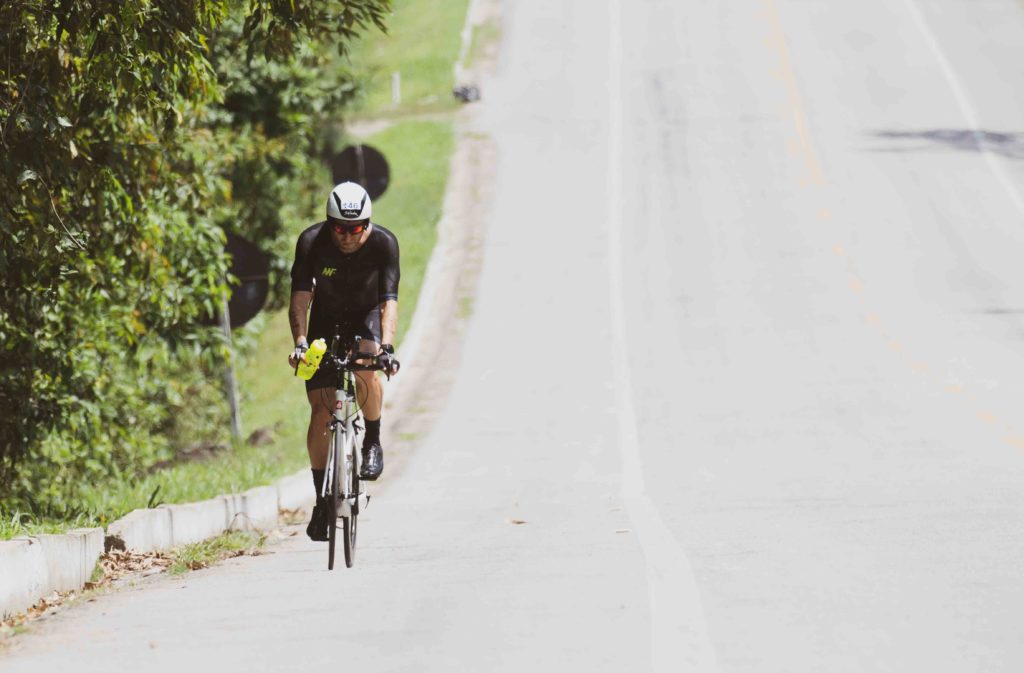Triathlon Fueling Basics

With a surge of adults seeking out challenges and ways to stay healthy, triathlon has collected swimmers, bikers and runners of all levels. The cross training required is an excellent way to include more of your body and become more fit. The obvious requirements are swimming, biking and running, but more often than not, I am writing race fueling plans for athletes who have got a few triathlons under their belts, trained well but suffered cramps or various types of GI distress that left their race short of expectations. They didn’t have triathlon fueling basics to get them to the finish line the way their training indicated it should.
Nutrition is so often overlooked as a part of race day execution, and nutrition is one of the few things you can control. (…along with your attitude, per Mike Reilly!)
Here are a few triathlon fueling basics based on some common mistakes I have seen to make sure your race day goes as well as can be expected. I always say, your training has gotten you to the starting line. Your execution can only allow you to hit your expectations or take away from them, but can not improve them.
Triathlon Fueling Basics
Before Race Day
MOST COMMON MISTAKE: Not practicing (or having!) a nutrition plan, winging it or purposefully withholding fuels to get more bang for your buck on race day.
Train your gut to handle amounts of carbohydrates and sodium close to what will be required on race day, and that will be relative to your race distance. Use long workouts close to race day to practice your race breakfast and your race nutrition.
Nothing new on race day. For example, don’t save caffeine for your race if you have never used it before. You don’t know how your body will react. Practice your plan and lock down what works. If you get your breakfast set and it works, don’t wing it on the next race. Repeat it and lock it in.
Race Day
MOST COMMON MISTAKE: Eating the wrong types of foods.
Just because a food is healthy doesn’t mean it’s the right food to eat on race day. Endurance athletics require carbohydrates and electrolyte repletion. While peanut/nut butter is a healthy choice, this food is a good source of fats and protein. Two things you don’t need in high amounts during a race.
Just because you can, doesn’t always mean you should. I sometimes hear, “I always have eggs, bacon and sausage with toast before a race and I never have any problems.” Imagine how you might execute your race if you ate what your body needed and not what you didn’t.
- Eating the wrong types of foods – Vitamin C in gels adds up, too much fat, fiber, protein
- Eating whatever breakfast is available – have your repeatable breakfast
- Only eat what you need for the race – mostly carbs, sodium, and length dependent, a small amount of amino acids.
MOST COMMON MISTAKE: Overdrinking plain water on long courses or in heat.
Sports drinks were designed to provide easily absorbed crbohydrates to replenish glycogen stores used up in prolonged physical activies and replace the electrolytes lost through sweat. Prior to this, hyponatremia or low sodium, was frequently seen primarily in marathons (mostly because that was the most popularized endurance event at that time). Sodium is a critical electrolyte and must be maintained in a certain range in the body. The body is amazing at doing this, but when we add excessive sweating without repletion, or ADEQUATE repletion, the sodium becomes diluted in the fluid in our bodies resulting in nausea, vomting, drowsiness, fatigue, confusion, cramps, seizures and in extreme cases, coma. Sips of water occassionally is not a problem. Not repleting your sodium is. Defer to sports drink or an electrolyte replenishing product.
Recovery
MOST COMMON MISTAKE:
Not doing it. Recovery is the athletes most important meal of the day, especially if there is another race around the corner. Recovery drinks should be used after most workouts, but athletes frequently eliminate these calories eager to drop a few pounds. These are not the calories to drop. Use a recovery product in relative amounts for the duration and intensity of your workout. A one hour bike ride might require less recovery than a 3 hour bike ride with some intensity dropped in.
As The Distance Increases
Nutrition becomes increasingly more important as the distance becomes longer. If you underfuel a sprint tri, you may not have your best race, but the course is likely short enough that in reasonable weather, you may not even know that your muscles were underfed for the event.
Underfueling/hydrating as the distance increases or as the temperature becomes hotter is a significant problem that can result in cramps, bloating, GI distress, inability to continue, dehydration and more severe conditions that land you in the medic tent that can be potentially life threatening.
TAKEAWAYS
- Always have a race fueling plan, and practice that plan at least 3 times. Remember that you very rarely have the opportunity to practice your day before carb load, breakfast and race fuel – practice what you can. Use key training sessions to come as close to this as possible.
- Focus on what your body needs for the race (carbs and sodium) and don’t put anything else in your gut that can get in the way or become a stressor the body has to manage.
- Replace your sodium with sports drink or electrolyte products.
- As your distance gets longer, increase your fuels and sports drink.
- Nothing new on race day
- If it’s hot, increase your fluids
- Recover yourself properly
Nutrition is a trainable aspect of your race. Don’t leave it to chance. Practice, practice, practice these triathlon fueling basics and good luck with all your upcoming races!

Anne Rollins was introduced to QT2 Systems and the sister company, The Core Diet, in 2008, and has provided nutrition plans and support for hundreds of athletes. She has coached triathletes for OutRival Racing, as well.
Anne is an Ironman and Ultra athlete, and created embodyFitness, a lifestyle transformation studio that provides coaching in all areas of life for all levels of people to live a happier and healthier life.
Anne holds a Master of Science, Nutrition and Dietetics from NYU, is a board Certified Specialist in Sports Dietetics, Registered Dietitian and Licensed Dietitian and Nutritionist in the state of Massachusetts, a USAT certified Level 1 Coach and certified personal trainer.









